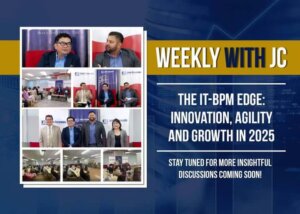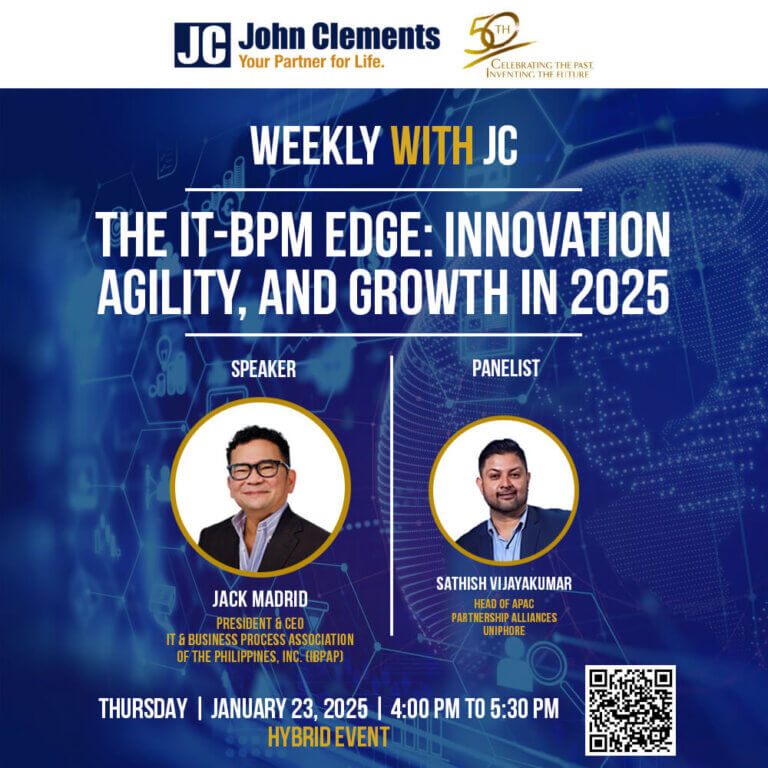On January 22, 2025, John Clements hosted the third session of the Weekly with JC Industry Briefing Series, titled “The IT-BPM Edge: Innovation, Agility, and Growth in 2025.” The session opened with remarks from Mario Biscocho, Senior Vice President and Managing Director of John Clements, followed by a keynote address from Jack Madrid, President and CEO of IBPAP, and a panel discussion featuring Sathish Kumar, Head of APAC for Uniphore.
Kicking Things Off: Mario Biscocho
Mario set the tone for the discussion by highlighting the IT-BPM sector’s pivotal role in the Philippine economy. He shared impressive figures—1.82 million direct employees, an additional 1.5 million jobs generated indirectly, and $38 billion in revenue. As the biggest contributor to the country’s GDP, the sector holds enormous potential for further growth.
He posed an intriguing question: What’s the one word that best describes the future of innovation in the IT-BPM industry? Responses ranged from smart solutions and AI to customer-centricity and cost-efficiency.
Key Takeaways from Jack Madrid’s Keynote
Jack delved into the essence of the IT-BPM industry, emphasizing that it’s no longer just about answering calls. The sector has evolved into a sophisticated, solutions-driven industry managing complex functions across various fields.
He backed this with data: 1.82 million employees, $38 billion in revenue, and an 8.5% contribution to the country’s GDP. Beyond voice-based customer service, the sector now provides specialized services in banking, healthcare, and technology.
One notable insight he shared was how major players like JP Morgan employ 28,000 people in the Philippines—not just for their English skills but for their expertise in banking and financial services. Similarly, healthcare BPOs such as Optum and Carelon now offer high-level services, including pharmacovigilance and care management.
Pandemic and the New Normal
Jack reflected on how the industry overcame the challenges posed by the pandemic. Within weeks, 1 million employees transitioned to remote work—a significant achievement considering connectivity issues and local government restrictions. Remarkably, customer satisfaction remained consistent, and the industry even created 255,000 new jobs during this time.
He acknowledged that hybrid work is here to stay, with companies redesigning office spaces to foster collaboration and knowledge-sharing.
AI’s Growing Role in the Industry
On the technology front, Jack shared that 67% of IT-BPM companies have already adopted AI in their operations. While some fear job losses—8% of companies reported this—13% saw job gains, demonstrating that AI is transforming roles rather than eliminating them entirely.
His advice? View AI as an opportunity. Resources for learning AI skills are widely available, and staying adaptable is key.
Insights from Sathish Kumar of Uniphore
Sathish, representing Uniphore—a leading AI enterprise operating in 20 countries with 1,500 customers—offered a compelling perspective on AI’s impact on the contact center industry. With 20 years of experience, he highlighted how the Philippines has become a global hub.
Addressing concerns about AI replacing jobs, he reassured attendees that while automation handles repetitive tasks, human skills like empathy and emotional intelligence remain irreplaceable. AI enables agents to focus on more meaningful and complex interactions.
Skills for the Future
When asked about skills essential in the AI era, Sathish emphasized problem-solving, analytical thinking, and adaptability. His message was clear: embrace AI and continuously upskill to remain competitive.
He also discussed how AI is transforming recruitment—automating manual processes and allowing recruiters to build stronger connections with candidates.
Challenges and Opportunities
The panel began by highlighting a critical challenge: only 15 out of every 100 applicants are hired. This concerning statistic emphasizes the urgent need to align education with industry requirements and better prepare graduates for job opportunities. Other challenges discussed included:
- Ease of doing business: Simplifying processes to attract more investors.
- Global competition: Competing with emerging IT-BPM destinations like South Africa, Poland, and Mexico.
- Talent development: Strengthening collaboration between industry and academia to ensure graduates meet industry standards.
The Road Ahead: IT-BPM’s Growth Plans
Looking forward, the IT-BPM industry has ambitious targets: creating 1.1 million new jobs, with 600,000 in the provinces, and generating an additional $29 billion in revenue. Jack expressed confidence that with the right strategies and collaboration, these goals are achievable.
He highlighted the Philippine Skills Framework, an initiative aimed at aligning education with industry demands, particularly in STEM fields.
Final Thoughts
The session concluded with a powerful message: innovation, agility, and growth will define the future of the IT-BPM industry. The opportunities are vast, and with the right mindset and strategies, the Philippines can maintain its leadership on the global stage.

Ready to Stay Ahead in the IT-BPM Industry?
The IT-BPM sector is evolving rapidly, and staying informed is key to seizing opportunities in 2025 and beyond. At John Clements, we specialize in connecting organizations with top talent, bridging the gap between industry needs and workforce readiness. Whether you’re looking to build a future-ready team or enhance your organization’s capabilities, we’re here to help.
Contact us today to discover how our expertise can support your growth in this dynamic industry.





